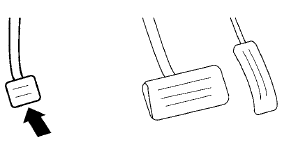Parking brake
WARNING
● Be sure the parking brake is fully released before driving. Failure to do so can cause brake failure and lead to an accident.
● Do not release the parking brake from outside the vehicle.
● Do not use the shift selector in place of the parking brake. When parking, be sure the parking brake is fully engaged.
● Do not leave children unattended in a vehicle. They could release the parking brake and cause an accident.

Type A
To engage: Type A, firmly depress the parking brake. Type B, pull the lever up A . To release:
1. Firmly apply the foot brake.
2. Manual transmission models:
Place the shift selector in the N (Neutral) position.
CVT models:
Move the shift selector to the P (Park) position.

Type B
3. Type A, firmly depress the parking brake pedal and it will release. Type B, while pulling up on the parking brake lever slightly, push the button and lower completely B .
4. Before driving, be sure the brake warning light goes out.
See also:
LATCH lower anchor location
LATCH lower anchor location
The LATCH lower anchors are located at the rear
of the seat cushion near the seatback. A label is
attached to the seatback to help you locate the
LATCH lower anchors. ...
Compressed Video Files (models with Navigation System)
Explanation of terms:
- DivX DivX refers to the DivXT codec
owned by Div, Inc. used for a lossy compression
of video based on MPEG-4.
- AVI AVI stands for Audio Video Interleave.
It is standard ...
Connecting iPod®
To connect an iPod® to the vehicle so that the
iPod® can be controlled with the audio system
controls and display screen, use the USB jack
located in the center console. Open the
protectiv ...
